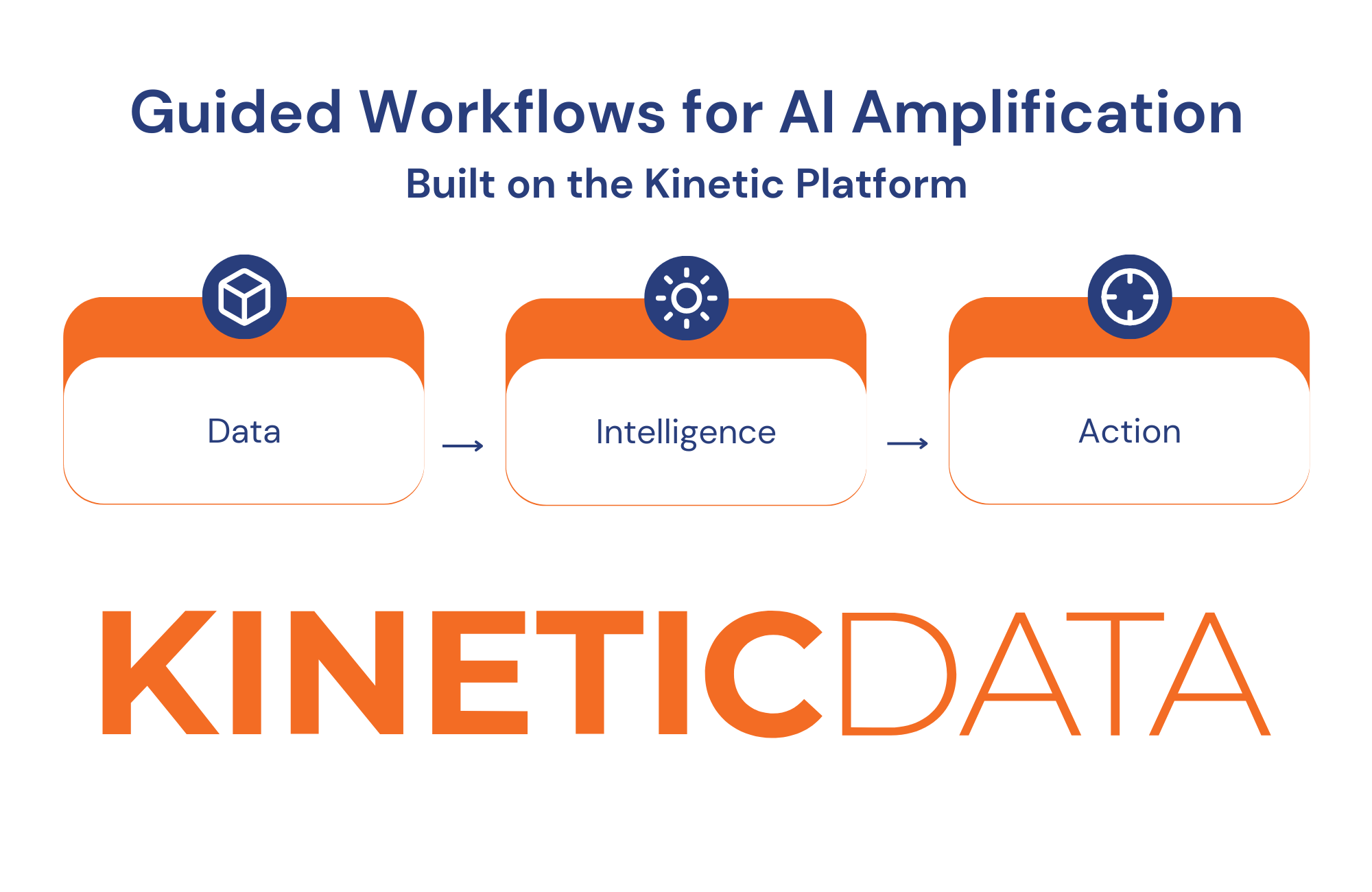Streamlining the ‘Data to Intelligence to Action’ Process in the DoD: The Kinetic Data Solution
Artificial Intelligence (AI) Use in the Military
Today, the Department of Defense (DoD) relies heavily on large quantities of data to make critical decisions in our ever-changing world. The data is crucial for strategic planning, carrying out operations and enabling swift reactions. Nevertheless, the process of “Data -> Intelligence -> Action” – an intricate sequence involving data storage, processing, analysis and eventual deployment – is not without its difficulties.
To overcome the obstacles the process presents, workflow automation that supports artificial intelligence (AI) in the military offer valuable benefits:
- Enhanced operational efficiency
- Accelerated decision-making
- Improved situational awareness
AI in the Military
The DoD uses a range of sophisticated tools at each step of this process, and these tools have been instrumental in a wide range of military applications:
- Sophisticated data storage systems ensure critical data is securely stored and accessible.
- Advanced processing tools transform raw data into usable forms.
- Powerful analytics algorithms help extract valuable insights from the processed data.
- Delivering to the Edge ensures these insights reach the warfighter in time to be actioned.
Each tool within the ecosystem performs its function admirably. Even so, the key challenge lies in harmonizing these distinct tools into a unified, coherent system.
Unleashing the Full Potential: How Kinetic Data Streamlines the “Data to Intelligence to Action” Workflow

Imagine the separate components of a complex machine. Each individual component is designed to perform its task with high precision. But without a robust workflow platform to fluidly connect these components, the full potential of the “Data to Intelligence to Action” process is obstructed.
This lack of integration results in siloed operations, delays in decision-making, and a less-than-optimal use of valuable data. In an environment as critical and high stakes as the DoD, there’s a pressing need for a comprehensive workflow solution that can effectively tie these disparate tools & processes together. And that’s exactly where Kinetic Data steps in.
Let’s delve into the “Data to Intelligence to Action” process, the existing challenges, AI use in the military and how Kinetic Data can help streamline this crucial workflow with a holistic solution.
What is the “Data to Intelligence to Action” Process Flow in the U.S. Military?
The “Data to Intelligence to Action” process in the U.S. Military is a complex yet critical operation, instrumental in driving strategic and timely decisions. AI in the military, combined with machine learning technologies, have amplified its potential by bringing unparalleled speed, accuracy and scalability.
Our Definition of “Data-to-Intelligence-to-Action”
Data Collection and Storage
The first step in this process is Data Collection and Storage. The military collects an overwhelming amount of data from various sources, from satellite imagery and drone feeds to intelligence reports and soldier-worn sensors.
Integrating these systems into a single repository is itself a workflow problem. Plus, this vast volume of data needs to be available with the right levels of security, access and portability for downstream applications.
Data Processing
The second step is Data Processing. Once stored, raw data needs to be processed into a usable format. This is where advanced AI algorithms come into play. They help parse through the vast datasets and transform unstructured data into structured information that can be analyzed.
AI technologies like Natural Language Processing (NLP) and Image Recognition are particularly useful in this stage, helping process text and visual data effectively. Today, dozens – if not hundreds — of AI platforms are used across the DoD. Workflow controls which tools have access to which data, and easily allows for the interchange of one tool for another for experimentation, iteration and growth.
Analysis
Step three is analysis. Processed data is analyzed for meaningful insights. AI and machine learning algorithms are also vital in this step for deciphering patterns, detecting anomalies and making predictions a human analyst might miss. With AI analytics, vast datasets can be processed in real time, providing the speed that’s vital in military decision-making. Again, massive investments have been made in this step.
Processing and Analysis form what we call the “Intelligence” sequence in our workflow process. Raw data in, insights out.
Edge
The final step is delivering to the Edge — getting the actionable data to the warfighter. This step is about ensuring critical insights and information reach the right people at exactly the right time.
With the help of automated workflow processes, delivering data-driven insights to the warfighter – even in low connectivity environments – is key to achieving the mission at hand. Receiving insights enhances situational awareness and decision-making ability in the field, increasing the probability of positive outcome.
Data-to-Intelligence-to-Action is a powerful, complex journey. But the power of this process is limited without a means of stitching these steps together seamlessly.
Current Challenges in DoD’s “Data to Intelligence to Action” Flow
Despite the technological advances in AI and machine learning enhancing each stage of the DoD “Data to Intelligence to Action” process, the system is not without its challenges. The most significant hurdle is the lack of an integrated workflow solution to cohesively tie these stages together.
Today, each stage of the process largely operates in a silo, using a specific set of tools optimized for its functions. While each tool is highly effective at its job, the disconnect between these systems can create bottlenecks in the workflow which slows down the whole process.
Information transfer from one stage to another can be inefficient, causing delays and potential loss of critical data. In a domain like the DoD where every second can make a difference, such delays are unacceptable.
Further complicating the process is the sheer variety and volume of data the military manages. This vast, diverse data landscape can cause big challenges in data management and exacerbate the disjointed nature of the current “Data to Intelligence to Action” process. The inability to efficiently streamline data from various sources into the process can lead to costly untapped potential and missed insights.
Finally, cybersecurity is a challenge within the military. With the increasing reliance on digital tools, DoD data is an attractive target for cyber-attacks, often by sophisticated hackers or rogue state actors. The current disparate system, with its distinct tools and platforms, presents multiple points of vulnerability that can be exploited. Zero Trust continues to grow in importance in this area.
While AI in the military has many advantages in the “Data to Intelligence to Action” process, the lack of a single workflow solution to integrate these disparate tools poses a big challenge.
The need for a solution that can seamlessly connect and streamline this process, ensuring efficient and secure data flow from storage to edge is more urgent than ever.
Our AI Workflow Solution for the DoD (aka “Guided Workflows for AI Amplification”)
Kinetic Data steps in as a powerful, comprehensive workflow solution to the current challenges plaguing the DoD “Data-to-Intelligence-to-Action” process. Our platform acts as the integrating agent to seamlessly stitch together the tools used in the process. This addresses the current disconnect as well as enables smoother, more efficient workflows in areas like analyst access requests, tracking and access removal, update requests and commentary (among others).
Our focus provides interoperability among the stages of the “Data to Intelligence to Action” process. Our automated workflow platform interfaces with the tools used at each step — from data storage and processing systems to analytics algorithms and edge systems.
By integrating these disparate tools, Kinetic Data eliminates the bottlenecks currently slowing down the process, ensuring a smooth transfer of information from one stage to the next.
Moreover, Kinetic Data recognizes the sheer volume and diversity of data that the military has to manage. Our solution is designed to help connect a wide range of data types and sources, ensuring all relevant data is efficiently funneled into the “Data to Intelligence to Action” process. It ensures no potential insights are missed and fully maximizes the value of the data.
Security is another critical concern we’ve addressed. Our platform is engineered with robust attribute-based access control (ABAC) security measures to verify and validate users at each stage of the process. By integrating the various tools with a single workflow platform, the points of vulnerability that could be exploited in a disjointed system are minimized to strengthen the holistic security of your “Data to Intelligence to Action” process.
In essence, we offer a comprehensive solution to streamline and secure the investments made in the “Data to Intelligence to Action” processes in the DoD. By connecting the dots and integrating the disparate tools involved, our platform ensures the processes are executed efficiently and securely, fully unleashing the power of machine learning and AI in military decision-making.
Kinetic Data Helps Connect the Components
In conclusion, the “Data to Intelligence to Action” process in the DoD is a complex operation crucial for informed, timely decision-making. AI has greatly improved the efficiency and potential of information analysis and insights. However, the lack of an integrated workflow solution to tie these systems together remains a costly challenge, causing delays, reducing efficiencies and ultimately missing delivery to the edge.
Kinetic Data provides a powerful solution to these challenges. By seamlessly integrating the disparate tools used at each stage of the “Data to Intelligence to Action” process, we ensure a smooth, efficient workflow from data to edge.
In addition, our platform handles a diverse range of data and incorporates robust security measures, significantly enhancing the effectiveness of the “Data to Intelligence to Action” process in the DoD.
As the digital landscape continues to evolve, the need for a comprehensive, secure and efficient workflow solution becomes more pressing. It’s time to break down the silos and fully unleash the power of AI in military decision-making with Kinetic Data.
Contact us to find out how.



